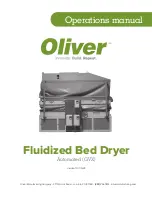
6
product will dry.
For normal use with ambient air, the typical operation of the machine is to set the fans
at 100% and then to adjust the deck speed until all of the heavier particles are able to
enter into the quasi-fluidic state, and then to adjust the End Raise until the product is just
dry at the end of the deck. For example, consider Figure 2.1. Here particles, represented
by red dots, have been put onto the deck (a), and the FBD has been set to have 100%
Fan Speed, and perhaps the deck has been set at 500 RPMs, and the particles have been
put into a quasi-fluidic state and are moving up the deck (b). When the particles are
tested at the end of the deck, they are dry, but they are also dry at the center part of the
deck. This means that the deck end raise can be increased, moving the deck towards a
flat position and a slope from the Feeder to the Discharge End (c). This will increase the
speed of the particles across the deck, decreasing the drying and process time. The Deck
Speed can also be increased instead of the Deck Angle.
On the other hand, the particles might be introduced to the deck and the fans turned
up to 100% and the Deck Speed set at 500 RPMs, and the deck angle could be too steep
from the Feed End to the Discharge, keeping the particles from drying. See Figure 2.2.
The particles are put on the deck (a) and the deck is adjusted but the particles are not
drying at the end of the deck. The Deck End Raise should be decreased to hold the
particles on longer so that the particles will dry.




























